IDENTIFYING THE ELEMENTS BY ANALYZING THEIR UNIQUE SPECTRA
In 1814, the German optician Joseph von Fraunhofer repeated Newton’s classic experiment of shining a beam of sunlight through a prism (recall Figure 3-1). However, Fraunhofer magnified the resulting rainbow-colored spectrum. He discovered that the solar spectrum contains hundreds of fine dark lines, which became known as absorption lines because the light of these colors has been absorbed by gases between the Sun and the viewer on Earth. Fraunhofer counted more than 600 such lines, and today physicists have detected more than 30,000 of them. Thousands of spectral lines are visible in the photograph of the Sun’s spectrum shown in Figure 3-44.
By the mid-1800s, chemists discovered that they could produce spectral lines in the laboratory. Around 1857, the German chemist Robert Bunsen invented a special gas burner that produces a clean, constant flame. Certain chemicals are easy to identify by the distinctive colors emitted when bits of the chemical are sprinkled into the flame of a Bunsen burner.
Bunsen’s colleague Gustav Kirchhoff suggested that light from the colored flames could best be studied by passing it through a prism. By separating the colors, the chemists could see exactly which ones were present. The process of analyzing the spectrum of an object is called spectroscopy. Bunsen and Kirchhoff collaborated in designing and constructing the first spectroscope. This device consists of a narrow slit, a prism, and several lenses that straighten the light rays and magnify the spectrum so that it can be closely examined (Figure 3-45).
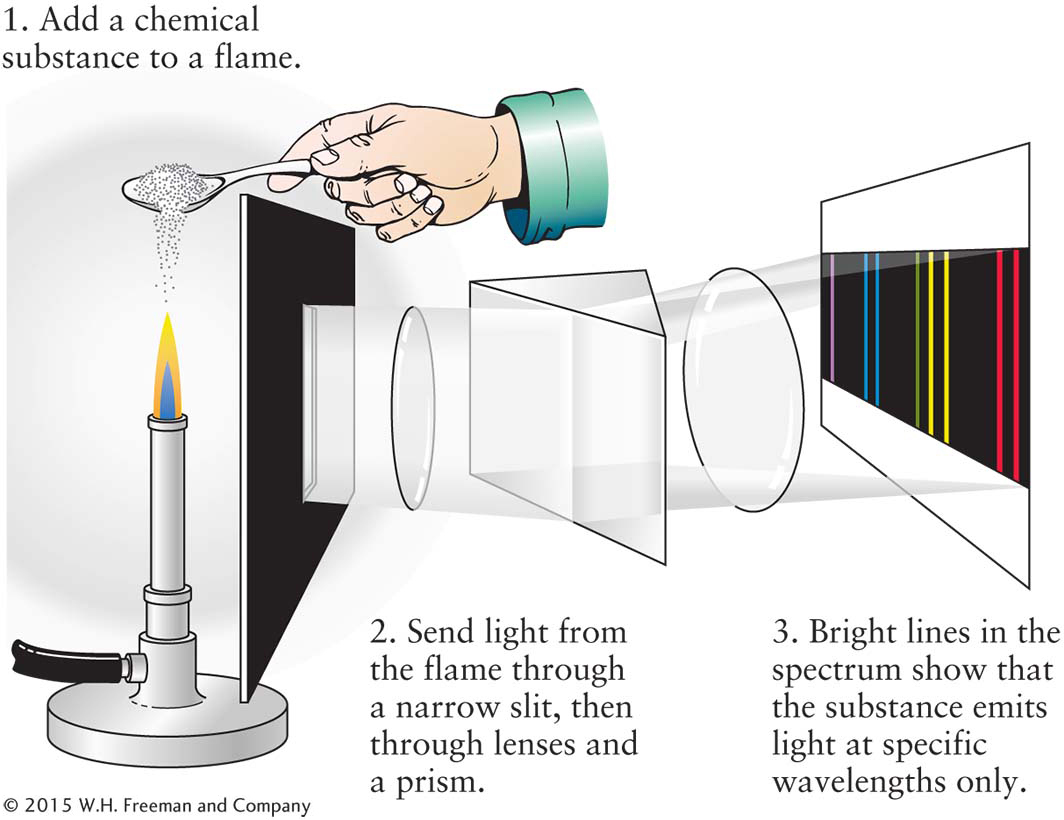
Figure 3-45 Early Spectroscope In the mid-1850s, Kirchhoff and Bunsen discovered that when a chemical substance is heated and vaporized, the resulting spectrum exhibits a series of bright spectral lines when passed through a slit, lenses, and a prism. This device is called a spectroscope. In addition, they found that each chemical element produces its own characteristic pattern of spectral lines. The lenses focus and magnify the spectrum.
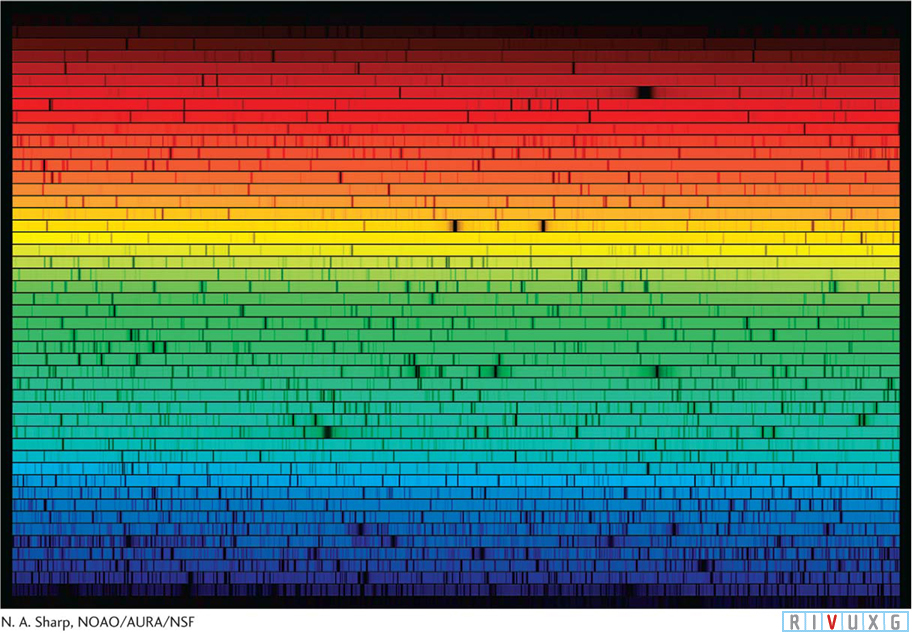
Figure 3-44  Solar Spectrum Starlight passing through a prism or diffraction grating spreads into its component colors. From such spectra we can learn an incredible amount about stars, including their masses, surface temperatures, diameters, chemical compositions, rotation rates, and motions toward or away from us. This image, called a spectrogram, shows the spectrum of the Sun sliced and stacked to fit on this page. In it you can see thousands of absorption lines. As you study spectra, also note the distinct differences between the intensities of the various colors emitted by each star and by different stars.
Solar Spectrum Starlight passing through a prism or diffraction grating spreads into its component colors. From such spectra we can learn an incredible amount about stars, including their masses, surface temperatures, diameters, chemical compositions, rotation rates, and motions toward or away from us. This image, called a spectrogram, shows the spectrum of the Sun sliced and stacked to fit on this page. In it you can see thousands of absorption lines. As you study spectra, also note the distinct differences between the intensities of the various colors emitted by each star and by different stars.
The chemists discovered that the spectrum from a chemical heated by a flame consists of a pattern of thin, bright spectral lines, called emission lines, against a dark background (not a blackbody spectrum!). They next found that the number of lines produced and their colors are unique to the element or compound heated to produce them. Thus, in 1859, the technique of spectral analysis, the identification of chemical substances by their spectral lines, was born.
3-14 Each chemical element produces its own unique set of spectral lines
A chemical element is a fundamental substance that cannot be broken down into more basic units while still retaining its properties. By the mid-1800s, chemists had already identified such familiar elements as hydrogen, oxygen, carbon, iron, gold, and silver. Spectral analysis promptly led to the discovery of additional elements, many of which are quite rare.
After Bunsen and Kirchhoff recorded the prominent spectral lines of all of the known elements, they began to discover other spectral lines in mineral samples. In 1860, for example, they found a new line in the blue portion of the spectrum of mineral water. After chemically isolating the previously unknown element responsible for the line, they named it cesium (from the Latin caesius, meaning “gray-blue”). The next year, a new spectral line in the red portion of the spectrum of a mineral sample led to the discovery of the element rubidium (from rubidus, for “red”).
During a solar eclipse in 1868, astronomers found a new spectral line in the light coming from the upper atmosphere of the Sun when the main body of the Sun was hidden by the Moon. This line was attributed to a new element, which was named helium (from the Greek helios, meaning “sun”). Helium was not actually discovered on Earth until 1895, when it was identified in gases obtained from a uranium compound.
The chemical elements are most conveniently displayed in the form of a periodic table (Appendix N: Periodic Table of the Elements). In addition to the 92 naturally occurring elements, there are artificially produced ones. All of the human-made elements are heavier than uranium (U), and all are highly radioactive, meaning that they spontaneously decay into lighter elements shortly after being created in the laboratory.
During some experiments, Bunsen and Kirchhoff examined the blackbody spectra of hot sources whose light they passed through cooler gas. Instead of seeing a continuum of wavelengths, as they would have seen had the cool gas not been there, they saw dark absorption lines among the colors of the rainbow created by the hot source. (This phenomenon is what Fraunhofer had seen earlier from the Sun—the cooler gases in his results were the atmospheres of Earth and the Sun.) In other experiments, when looking just at gases without hot sources behind them, they saw bright emission lines against otherwise dark backgrounds. Combining the results from both sets of experiments, they discovered that the emission lines of a particular gas occur at exactly the same wavelengths as the absorption lines of that gas.
Because each chemical element produces its own unique pattern of spectral lines, scientists can determine the chemical composition of a remote astronomical object by identifying the lines in its spectrum. For example, Figure 3-46 shows a portion of the Sun’s absorption spectrum in the blue-violet part of the spectrum, along with the emission spectrum of an iron sample taken here on Earth. The spectral lines of iron also appear in the Sun’s spectrum, so we can reasonably conclude that the Sun’s atmosphere contains some vaporized iron. This gaseous iron absorbs and then scatters certain wavelengths from the continuum emitted below it in all directions, preventing that light from reaching Earth.

Figure 3-46  Iron in the Sun’s Atmosphere The upper ( absorption) spectrum is a portion of the Sun’s spectrum from 425 to 430 nm. Numerous dark spectral lines are visible. The lower (emission) spectrum is a corresponding portion of the spectrum of vaporized iron. Several emission lines can be seen against the black background. The iron lines coincide with some of the solar absorption lines, proving that there is some iron (albeit a very tiny amount) in the Sun’s atmosphere.
Iron in the Sun’s Atmosphere The upper ( absorption) spectrum is a portion of the Sun’s spectrum from 425 to 430 nm. Numerous dark spectral lines are visible. The lower (emission) spectrum is a corresponding portion of the spectrum of vaporized iron. Several emission lines can be seen against the black background. The iron lines coincide with some of the solar absorption lines, proving that there is some iron (albeit a very tiny amount) in the Sun’s atmosphere.
After photography was invented, scientists preferred to do spectroscopy by making a permanent photographic record of spectra. A device for photographing a spectrum is called a spectrograph, and this instrument, in its numerous variations, is the astronomer’s most important tool.
In its earliest form, a spectrograph was attached directly to a telescope. It consisted of a slit, two lenses, and a prism arranged to focus the spectrum of an object on film, similar to the device sketched in Figure 3-45. Although conceptually straightforward, this early type of spectrograph had severe drawbacks. A prism does not spread colors evenly: The blue and violet portions of the spectrum are spread out more than the red portion. In addition, because the blue and violet wavelengths must pass through more glass than the red wavelengths (see Figure 3-1), light is absorbed in the prism unevenly across the spectrum. Indeed, a glass prism is opaque to ultraviolet wavelengths.
Practical spectrographs used in research today (shown conceptually in Figure 3-47a) separate light from objects in space into the colors of the rainbow using a diffraction grating, which is a piece of glass or plastic on which thousands of closely spaced parallel grooves are cut or etched. Some of the finest diffraction gratings have more than 10,000 grooves per centimeter. The spacing of the grooves must be very regular. Light waves are diffracted by the grooves in the diffraction grating, just as light or water waves are diffracted when passing through slits (see Figure 3-2). Some diffraction gratings have the light pass through them, while others have the light reflect off their surfaces, as shown in Figure 3-47a. Different wavelengths are diffracted by different amounts and so they are spread out, just as occurs when the light passes through a glass prism.
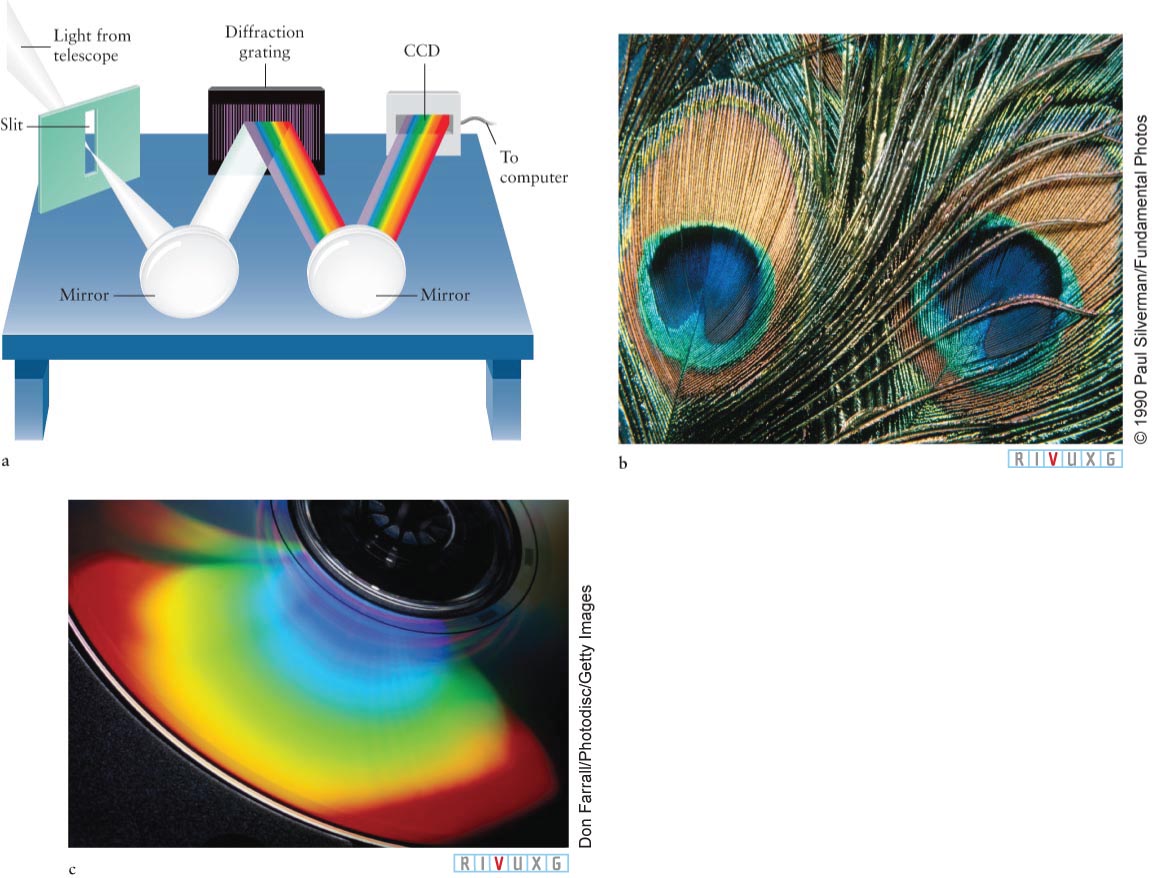
Figure 3-47 
 A Grating Spectrograph (a) The diffraction grating in a grating spectrograph has many parallel lines on its surface that reflect light of different colors in different directions. This separation of colors (wavelengths) allows the object’s spectrum to be analyzed. (b) This peacock feather contains numerous natural diffraction gratings. The role of the parallel lines etched in a human-made diffraction grating is played by parallel rods of the protein melanin in the feathers. (c) CDs and DVDs store information on closely spaced bumps located on a set of nearly parallel tracks. Light striking these tracks systematically reflects different colors in different directions—a CD or a DVD behaves like a diffraction grating.
A Grating Spectrograph (a) The diffraction grating in a grating spectrograph has many parallel lines on its surface that reflect light of different colors in different directions. This separation of colors (wavelengths) allows the object’s spectrum to be analyzed. (b) This peacock feather contains numerous natural diffraction gratings. The role of the parallel lines etched in a human-made diffraction grating is played by parallel rods of the protein melanin in the feathers. (c) CDs and DVDs store information on closely spaced bumps located on a set of nearly parallel tracks. Light striking these tracks systematically reflects different colors in different directions—a CD or a DVD behaves like a diffraction grating.
Insight Into Science
Seek Relationships Finding how properties of different things relate to one another often provides invaluable insights into how they work. The periodic table, for example, enables scientists to determine the properties of similar chemical elements. Keep an eye out for other such relationships throughout this book.
Figure 3-47a shows the design of a modern diffraction grating spectrograph with a CCD (charge-coupled device; see Figure 3-25) that has replaced film to record the spectra. This optical device typically mounts at the Nasmyth, coudé, or Cassegrain focal point of a telescope. The image of the object to be examined is focused on the slit. After the spectrum of a star, galaxy, or other object has been recorded, the CCD collects an emission spectrum from a known source, such as a gas composed of helium, neon, and argon, which is also focused on the slit. This “comparison spectrum” is placed next to the spectrum of the object, as in Figure 3-46. Because the wavelengths of the spectral lines in the comparison spectrum are already known from laboratory experiments, these lines can be used to identify and measure the wavelengths of the lines in the spectrum of the star or galaxy under study. Figures 3-47b and 3-47c show diffraction spectra occurring on Earth.
The spectral data are converted by computer to a graph that plots light intensity against wavelength. Dark lines in the rainbow-colored spectrum appear as depressions or valleys on the graph, while bright lines in the spectrum appear as peaks. For example, Figure 3-48 shows both an absorption spectrum and an emission spectrum for hydrogen. The five absorption lines (Figures 3-48a, b) occur at precisely the same wavelengths as the five emission lines for hydrogen (Figures 3-48c, d).
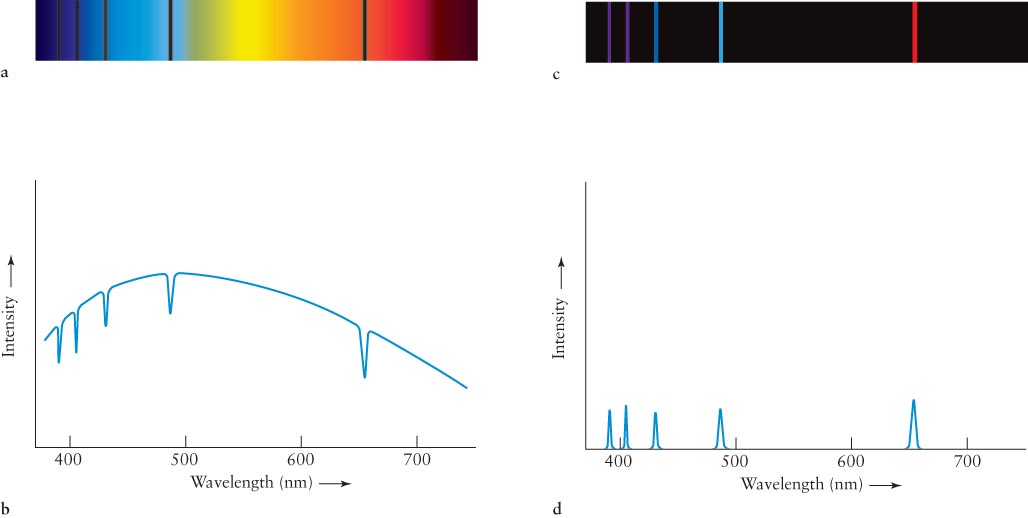
Figure 3-48 Spectrum of Hydrogen Gas (a) When a CCD is placed at the focus of a spectrograph, the spectrum is recorded. I n this case, the spectrum is from a hot object whose light shines through hydrogen gas. (b) This spectrum is converted by computer into a graph of intensity versus wavelength. Note that the absorption lines appear as dips in the intensity-versus-wavelength curve. Conversely, when a gas emits only a few wavelengths, (c) its emission spectrum appears as a series of bright lines, which is converted into peaks (d) on a graph of intensity versus wavelength.
3-15 The various brightness levels of spectral lines depend on conditions in the spectrum’s source
By the early 1860s, Kirchhoff had discovered the conditions under which different types of spectra are observed. His description is summarized today as Kirchhoff’s laws:
Law 1 A solid, liquid, or dense gas produces a continuous spectrum (also called a continuum)—a complete rainbow of colors without any spectral lines. This is a blackbody spectrum.
The light emitted by a hot iron rod and by an incandescent lightbulb are examples of continuous spectra that are bright enough for us to see.
Focus Question 3-12
Diffraction gratings can either reflect or transmit light to create spectra. Are the peacock feathers in Figure 3-47b reflection or transmission diffraction gratings?
Law 2 A rarefied (opposite of dense) gas produces an emission line spectrum—a series of bright spectral lines against a dark background.
The light emitted by neon lights and by low-pressure sodium vapor lights are examples of emission line spectra. The neon has bright-red emission lines, while the low-pressure sodium has bright-yellow lines.
Law 3 The light from an object with a continuous spectrum that passes through a cool gas produces an absorption line spectrum—a series of dark spectral lines among the colors of the rainbow.
Sunlight and the light from other stars pass through several cooler gases on their way to us. Hence, light from stars produces absorption line spectra.
In summary (Figure 3-49), a continuum is seen if there is no gas between a blackbody and the observer; absorption lines are seen if the background object is hotter than the gas between the observer and the object; and emission lines are seen if the background is cooler than such a gas.
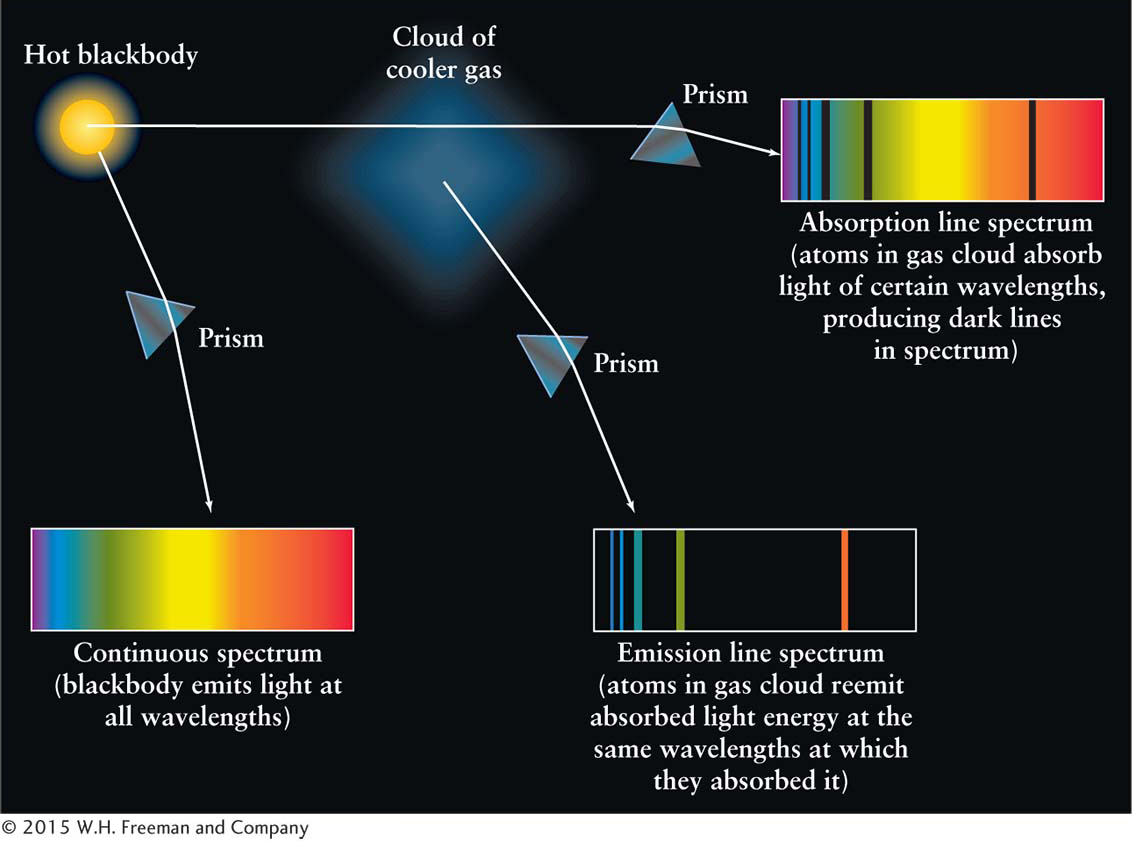
Figure 3-49 Continuous, Absorption Line, and Emission Line Spectra This schematic diagram summarizes how different types of spectra are produced. The prisms are added for conceptual clarity, but in real telescopes diffraction gratings are used to separate the colors. A hot, glowing object emits a continuous spectrum. If this source of light is viewed through a cool gas, dark absorption lines appear in the resulting spectrum. When the same gas is viewed against a cold, dark background, its spectrum consists of just bright emission lines.
Consider, for example, the spectrum of the Sun. We know that the Sun’s surface emits a continuous blackbody spectrum, but here on Earth many absorption lines are seen in it (see Figure 3-44). Kirchhoff’s third law explains why. There must be a cooler gas between the surface of the Sun and Earth. In fact, as noted earlier, there are two such gases: the Sun’s lower atmosphere and Earth’s entire atmosphere. Using the catalogs of spectra of different elements, the absorption lines in the Sun’s spectrum tell us the chemical composition of the Sun’s lower atmosphere and that of Earth’s atmosphere.
If you have younger siblings or are around children a lot, you are likely to hear them go through a stage of development in which they frequently ask, “Why?” Scientists retain that curiosity, and the appearance of spectra is just one of a myriad of things about which they ask “why?” Fortunately, we can answer this question now, and the insights that it provides will be useful in comprehending concepts in virtually every chapter of this book. Our first step in understanding how spectra arise is to explore the building blocks of matter: atoms.






 Solar Spectrum Starlight passing through a prism or diffraction grating spreads into its component colors. From such spectra we can learn an incredible amount about stars, including their masses, surface temperatures, diameters, chemical compositions, rotation rates, and motions toward or away from us. This image, called a spectrogram, shows the spectrum of the Sun sliced and stacked to fit on this page. In it you can see thousands of absorption lines. As you study spectra, also note the distinct differences between the intensities of the various colors emitted by each star and by different stars.
Solar Spectrum Starlight passing through a prism or diffraction grating spreads into its component colors. From such spectra we can learn an incredible amount about stars, including their masses, surface temperatures, diameters, chemical compositions, rotation rates, and motions toward or away from us. This image, called a spectrogram, shows the spectrum of the Sun sliced and stacked to fit on this page. In it you can see thousands of absorption lines. As you study spectra, also note the distinct differences between the intensities of the various colors emitted by each star and by different stars.